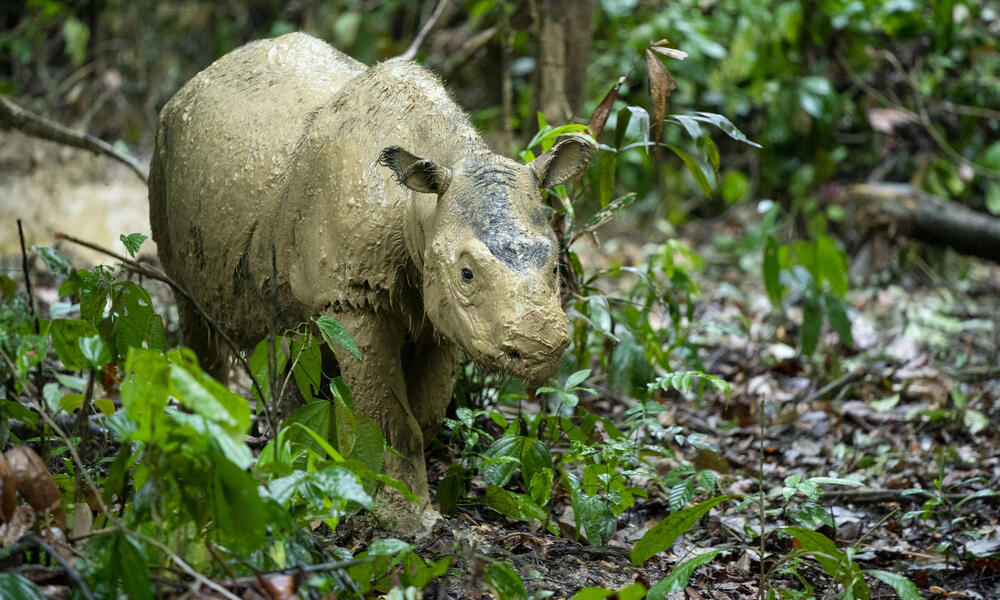
Sumatran rhinos, the smallest of the living rhinoceros species and the only Asian rhino with two horns, occupy a unique and critical position in the animal kingdom. Covered with long hair and bearing a striking resemblance to their extinct woolly rhino relatives, these magnificent creatures are teetering on the brink of extinction. In this article, we delve into the world of Sumatran rhinos, exploring their distinct characteristics, the dire threats they face, and the heroic efforts being made to save them from oblivion.
The Last of a Unique Lineage

Sumatran rhinos stand out among their rhino counterparts due to their small size and distinctive features. Unlike other Asian rhinos, they possess two horns and are covered in long, shaggy hair. This furry exterior sets them apart, making them look more like their long-extinct woolly rhino relatives than their living rhino cousins.
A Battle for Survival
Sumatran rhinos find themselves in a fierce competition with the Javan rhino for the title of the most threatened rhino species. Although there may be more Sumatran rhinos in existence compared to Javan rhinos, their survival is far more precarious. The primary culprits behind their critical status are habitat loss and fragmentation.
These rhinos now exist in small, fragmented populations, making it increasingly difficult for them to find suitable mates for breeding. In the past 15 years, only two captive females have successfully reproduced, underscoring the challenges they face in the wild.
A Shrinking Range
Once ranging across vast territories, Sumatran rhinos have seen their habitat dramatically reduced. Today, they can only be found on the Indonesian islands of Sumatra and Borneo. Experts fear that the third subspecies may have already succumbed to extinction.
Grave Threats

Small Population Size and Isolation
The small number of remaining Sumatran rhinos poses a significant hurdle to their survival. With limited opportunities for breeding pairs to encounter each other, and the reproductive difficulties faced by aging females, wild Sumatran rhino populations are in dire straits. Many sub-populations are too small to be viable in the long term.
Illegal Wildlife Trade
The demand for rhino horn, driven by its purported medicinal qualities and social prestige, has led to rampant poaching across Africa and Asia. China and Vietnam are the biggest consumer markets for rhino horn, with traditional medicine use persisting in many countries. This illegal trade has dealt a devastating blow to rhino populations.
Habitat Loss
Sumatran rhino habitats are under constant threat from invasive species, road construction, and encroachment for agriculture. Protected areas like Bukit Barisan Selatan National Park in Sumatra are losing precious forest cover to illegal settlers.
Lack of Protection
The inadequate protection of existing conservation areas leaves rhinos vulnerable. When they venture beyond these boundaries, local communities often lack the incentive and resources to safeguard them.
The Fight to Save Sumatran Rhinos
Amidst these formidable challenges, WWF (World Wildlife Fund) is leading the charge to rescue Sumatran rhinos from the brink of extinction. Their multifaceted approach includes:
Supporting Rhino Protection Units
WWF provides crucial support to rhino protection units in key habitats, such as Bukit Barisan Selatan and Way Kambas National Parks, to combat wildlife crime and safeguard the remaining rhino populations.
Monitoring Rhino Distribution and Population Size
WWF employs cutting-edge technologies like camera traps and environmental DNA to monitor rhino populations in the wild accurately. This data informs conservation efforts and helps protect these magnificent creatures.
Managing Populations
Working closely with the Indonesian government and partner organizations, WWF assesses the risk levels of sub-populations and identifies immediate protection needs. They are also moving isolated and small groups of rhinos to safer locations to bolster population numbers.
Engaging with Key Governments and Partners
WWF collaborates with high-level government officials and conservation organizations worldwide to develop a long-term recovery plan for Sumatran rhinos.
Rescuing Sumatran Rhinos
WWF, in collaboration with other organizations, launched the Sumatran Rhino Rescue Alliance. This ambitious effort aims to relocate dispersed rhino populations to managed breeding facilities, providing a safe haven for their care and the potential for population growth.
In the face of extinction, Sumatran rhinos have found a lifeline in the dedicated efforts of conservation organizations like WWF and their allies. While the challenges are immense, the determination to ensure these remarkable creatures endure for future generations is unwavering. With continued support and action, we can hope to witness a brighter future for Sumatran rhinos—one where they no longer teeter on the precipice of extinction but thrive in the wild once more.

Leave a Reply